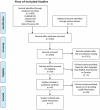Risk factors for neck and upper extremity disorders among computers users and the effect of interventions: an overview of systematic reviews
- PMID: 21589875
- PMCID: PMC3093401
- DOI: 10.1371/journal.pone.0019691
Risk factors for neck and upper extremity disorders among computers users and the effect of interventions: an overview of systematic reviews
Abstract
Background: To summarize systematic reviews that 1) assessed the evidence for causal relationships between computer work and the occurrence of carpal tunnel syndrome (CTS) or upper extremity musculoskeletal disorders (UEMSDs), or 2) reported on intervention studies among computer users/or office workers.
Methodology/principal findings: PubMed, Embase, CINAHL and Web of Science were searched for reviews published between 1999 and 2010. Additional publications were provided by content area experts. The primary author extracted all data using a purpose-built form, while two of the authors evaluated the quality of the reviews using recommended standard criteria from AMSTAR; disagreements were resolved by discussion. The quality of evidence syntheses in the included reviews was assessed qualitatively for each outcome and for the interventions. Altogether, 1,349 review titles were identified, 47 reviews were retrieved for full text relevance assessment, and 17 reviews were finally included as being relevant and of sufficient quality. The degrees of focus and rigorousness of these 17 reviews were highly variable. Three reviews on risk factors for carpal tunnel syndrome were rated moderate to high quality, 8 reviews on risk factors for UEMSDs ranged from low to moderate/high quality, and 6 reviews on intervention studies were of moderate to high quality. The quality of the evidence for computer use as a risk factor for CTS was insufficient, while the evidence for computer use and UEMSDs was moderate regarding pain complaints and limited for specific musculoskeletal disorders. From the reviews on intervention studies no strong evidence based recommendations could be given.
Conclusions/significance: Computer use is associated with pain complaints, but it is still not very clear if this association is causal. The evidence for specific disorders or diseases is limited. No effective interventions have yet been documented.
Conflict of interest statement
Figures





Similar articles
-
Upper-extremity and neck disorders associated with keyboard and mouse use.Handb Clin Neurol. 2015;131:427-33. doi: 10.1016/B978-0-444-62627-1.00022-6. Handb Clin Neurol. 2015. PMID: 26563801 Review.
-
Associations of screen work with neck and upper extremity symptoms: a systematic review with meta-analysis.Occup Environ Med. 2019 Jul;76(7):502-509. doi: 10.1136/oemed-2018-105553. Epub 2019 Mar 20. Occup Environ Med. 2019. PMID: 30894425
-
Workplace interventions for increasing standing or walking for decreasing musculoskeletal symptoms in sedentary workers.Cochrane Database Syst Rev. 2019 Nov 17;2019(11):CD012487. doi: 10.1002/14651858.CD012487.pub2. Cochrane Database Syst Rev. 2019. PMID: 31742666 Free PMC article.
-
Beyond the black stump: rapid reviews of health research issues affecting regional, rural and remote Australia.Med J Aust. 2020 Dec;213 Suppl 11:S3-S32.e1. doi: 10.5694/mja2.50881. Med J Aust. 2020. PMID: 33314144
-
Effectiveness of Surgical and Postsurgical Interventions for Carpal Tunnel Syndrome-A Systematic Review.Arch Phys Med Rehabil. 2018 Aug;99(8):1660-1680.e21. doi: 10.1016/j.apmr.2017.04.024. Epub 2017 May 31. Arch Phys Med Rehabil. 2018. PMID: 28577858
Cited by
-
Visual and psychological stress during computer work in healthy, young females-physiological responses.Int Arch Occup Environ Health. 2018 Oct;91(7):811-830. doi: 10.1007/s00420-018-1324-5. Epub 2018 May 30. Int Arch Occup Environ Health. 2018. PMID: 29850947 Free PMC article.
-
Relations between work and upper extremity musculoskeletal problems (UEMSP) and the moderating role of psychosocial work factors on the relation between computer work and UEMSP.Int Arch Occup Environ Health. 2017 Nov;90(8):751-764. doi: 10.1007/s00420-017-1236-9. Epub 2017 Jun 23. Int Arch Occup Environ Health. 2017. PMID: 28646281
-
Musculoskeletal symptoms and computer use among Finnish adolescents--pain intensity and inconvenience to everyday life: a cross-sectional study.BMC Musculoskelet Disord. 2012 Mar 22;13:41. doi: 10.1186/1471-2474-13-41. BMC Musculoskelet Disord. 2012. PMID: 22439805 Free PMC article.
-
Psychological Care, Patient Education, Orthotics, Ergonomics and Prevention Strategies for Neck Pain: An Systematic Overview Update as Part of the ICON Project.Open Orthop J. 2013 Sep 20;7:530-61. doi: 10.2174/1874325001307010530. eCollection 2013. Open Orthop J. 2013. PMID: 24133554 Free PMC article.
-
The Health Effects of Passive Smoking: An Overview of Systematic Reviews Based on Observational Epidemiological Evidence.PLoS One. 2015 Oct 6;10(10):e0139907. doi: 10.1371/journal.pone.0139907. eCollection 2015. PLoS One. 2015. PMID: 26440943 Free PMC article. Review.
References
-
- Maeda K. Occupational cervicobrachial disorder and its causative factors. J Hum Ergol. 1977;6:193–202. - PubMed
-
- Dembe AE. New Haven and London: Yale University Press; 1996. Occupation and disease – How social factors affect the conception of work-related disorders.344
-
- Lucire Y. Sydney: UNSW Press; 2003. Constructing RSI: Belief and Desire.216
-
- Hadler NM. A Keyboard for “Daubert”. J Occup Environ Med. 1996;38:469–476. - PubMed
Publication types
MeSH terms
LinkOut - more resources
Full Text Sources
Medical
Research Materials

